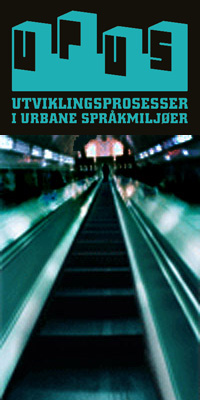About the project
The overarching goal of the national project was to discuss a possible identification of one or more new varieties of Norwegian which might be traced to influences from a multilingual environment.
UPUS-Oslo was managed by The Department of Linguistics and Scandinavian Studies (ILN) and studied linguistic practices among adolescents in multilingual and multicultural communities of practice in Oslo.
Multilingual Oslo
Linguistic diversity in Norway has increased dramatically during the last 30-40 years, primarily as a consequence of migration. In Oslo, the capital, more than one third of pupils in primary and secondary school are so-called minority language speaking, and more than 120 different languages are represented.
Even though the statistics bear witness to an immensely differentiated language situation, it does not tell us about the factual vitality of these languages, neither about how, and to which purposes the languages are used, nor how the languages interact.
Multiethnolectal Norwegian
The idea that a new way of speaking Norwegian has emerged among adolescents in multilingual environments in Oslo has already been established in the media and among people in general. However, there has, as yet, not been any comprehensive study of this phenomenon apart from some smaller studies of lexical loans. Within the UPUS-project we studied the linguistic traits which characterize these adolescents way of speaking Norwegian, but also their bi- or multilingual language socialization, especially in their families, but also at school and among their peers.
The researches in the project examined slightly different aspects. Whereas some concentrated on phonology/ prosody, morphology or syntax others concentrated on functions or repertoires.
Objectives
The different research questions was as follows:
- Are one or more multiethnolectal style(s) emerging in Oslo – as found for example in Hamburg, Mannheim, Stockholm, Utrecht?
- Can we differentiate these multiethnolectal style(s) from more idiosyncratic second language learner style(s) and from more general changes in progress?
- Are these multiethnolectal style(s) also used to some extent by monolingual adolescents?
- To what extent can we connect certain linguistic practice(s) or linguistic traits to a (co-)construction of identities along dimensions such as youth, ethnicity, urbanity and gender?
Fieldwork and data
We concentrated our field work to two local communities of practice, one in the southern part of the city and one in the old part of Oslo. Both of these areas have a migrant population of aprox 35 %. We collected video-taped interviews and peer conversations both at schools, in families and among peer groups. We gathered data from aprox 90 adolescents.
The data was transcribed and is available through an internet based interface developed by Text Laboratory. To get access to the material you must send an application to UPUS-Oslo and The Norwegian Social Science Data Services (NSD). The data is only available for research.
